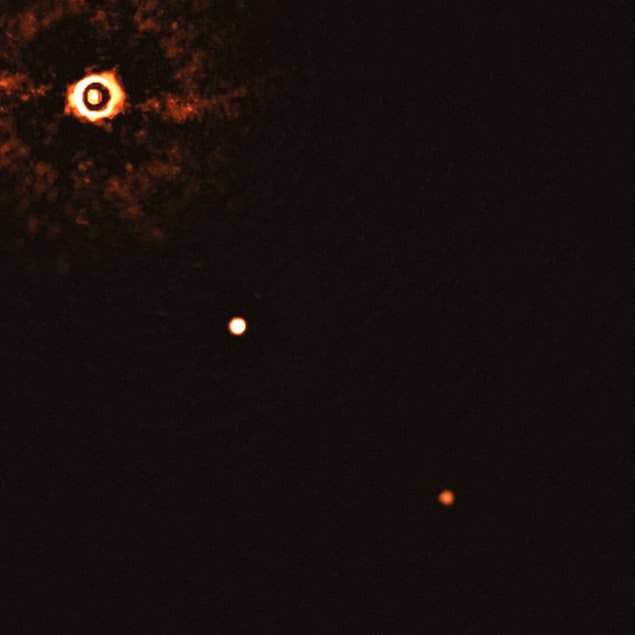
The first ever direct image of a young Sun-like star accompanied by two giant exoplanets has been captured by astronomers using the Very Large Telescope (VLT) in Chile. The two planets are orbiting the star TYC 8998-760-1, which lies 300 light-years away from Earth. The star has an almost identical mass to our Sun, but is just 17 million years old compared with 4.6 billion years for our Sun.
Perhaps the most striking feature of this system is the large mass of the planets and their giant oribits. The inner planet has 14 times Jupiter’s mass and the outer one six times. They orbit at distances of roughly 160 and 320 times the Earth-Sun distance respectively, which is more than 30 times larger than the orbits of Jupiter and Saturn.
This discovery is a snapshot of an environment that is very similar to our Solar System, but at a much earlier stage of its evolution.
Alexander Bohn, Leiden University
“This discovery is a snapshot of an environment that is very similar to our Solar System, but at a much earlier stage of its evolution,” says Alexander Bohn from at Leiden University in the Netherlands, who led the new research, published in Astrophysical Journal Letters.
A turbulent past
Bohn told Physics World that this system might represent the lower mass end of multiple star formation. In other words, had a bit more stuff accreted from the protostellar cloud, then this could have resulted in a binary star system, rather than one star and two huge planets.
Alternatively, these giant planets could be the result of several small planetessimals clustering together into cores, which eventually gained enough gravitational pull to accrete gas from the circumstellar disk. This is the favoured scenario for the formation of the largest planets in our own Solar System.
“To explain the large separations of our detected planets, however, some kind of outward migration is required,” says Bohn. “This can be performed by gravitationally scattering off of each other or with another, so far undetected, third object in the system.”
To date, more than 4000 exoplanets have been detected. However, the vast majority of these have been spotted using indirect methods, such as observing the dip in starlight as a planet transits between its parent star and our line of sight.
Only a tiny fraction of these planets has been directly observed, and the direct imaging of two or more exoplanets around the same star is even rarer. Only two such systems have been directly observed so far, both around stars markedly different from our Sun.
Hot young planets
These latest images were possible due to the SPHERE instrument on the VLT at the European Southern Observatory (ESO) in Chile, which uses a coronagraph to block bright starlight, allowing much fainter planets to be seen. While older planets, such as those seen in our Solar System, are too cool to be found with this technique, young planets are hotter, and so glow brighter in infrared light.
This discovery still tells us that there is not just one way to form a planetary system.
Carlo Felice Manara, European Southern Observatory
“This discovery still tells us that there is not just one way to form a planetary system, and the outcome of the process can be very different,” says Carlo Felice Manara, an astronomer based at ESO headquarters in Germany, who was not involved in this latest research. “Why in our Solar System we only have planets with mass of Jupiter, or less, and no more massive planets is still an open question.”

Life under alien skies
Further observations of TYC 8998-760-1 system will enable astronomers to better understand its dynamics. ESO’s Extremely Large Telescope – scheduled to capture its first astronomical images in 2025 – could even detect further planets with Neptune or Saturn masses. Unfortunately, even that instrument is unlikely to detect rocky planets similar to Earth, as these are just too faint.
